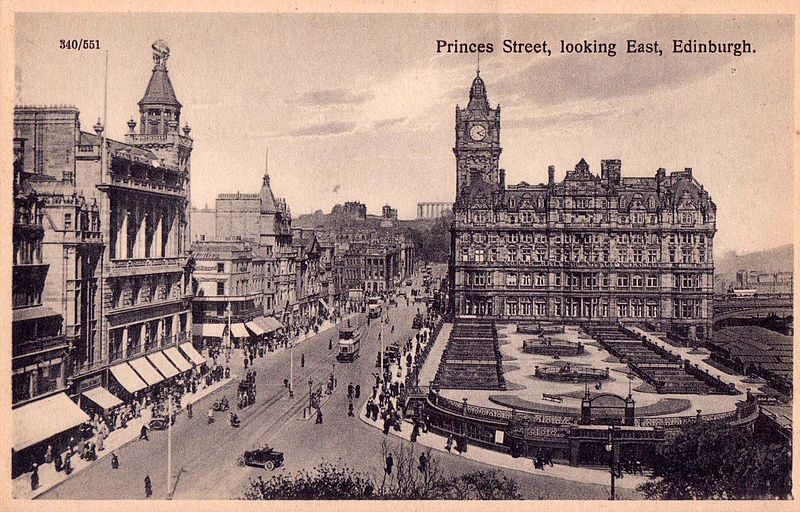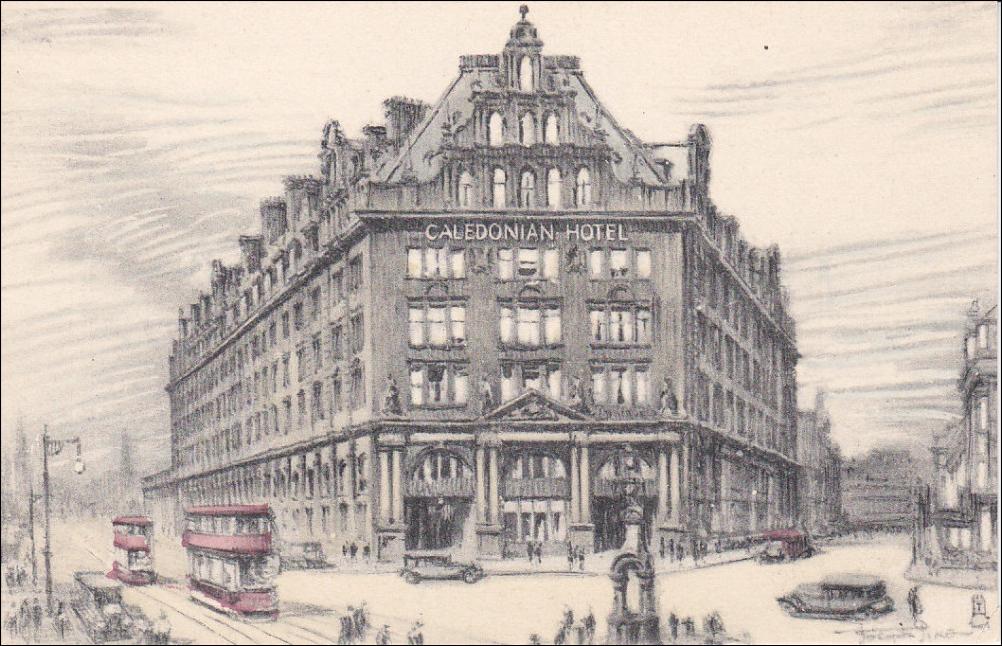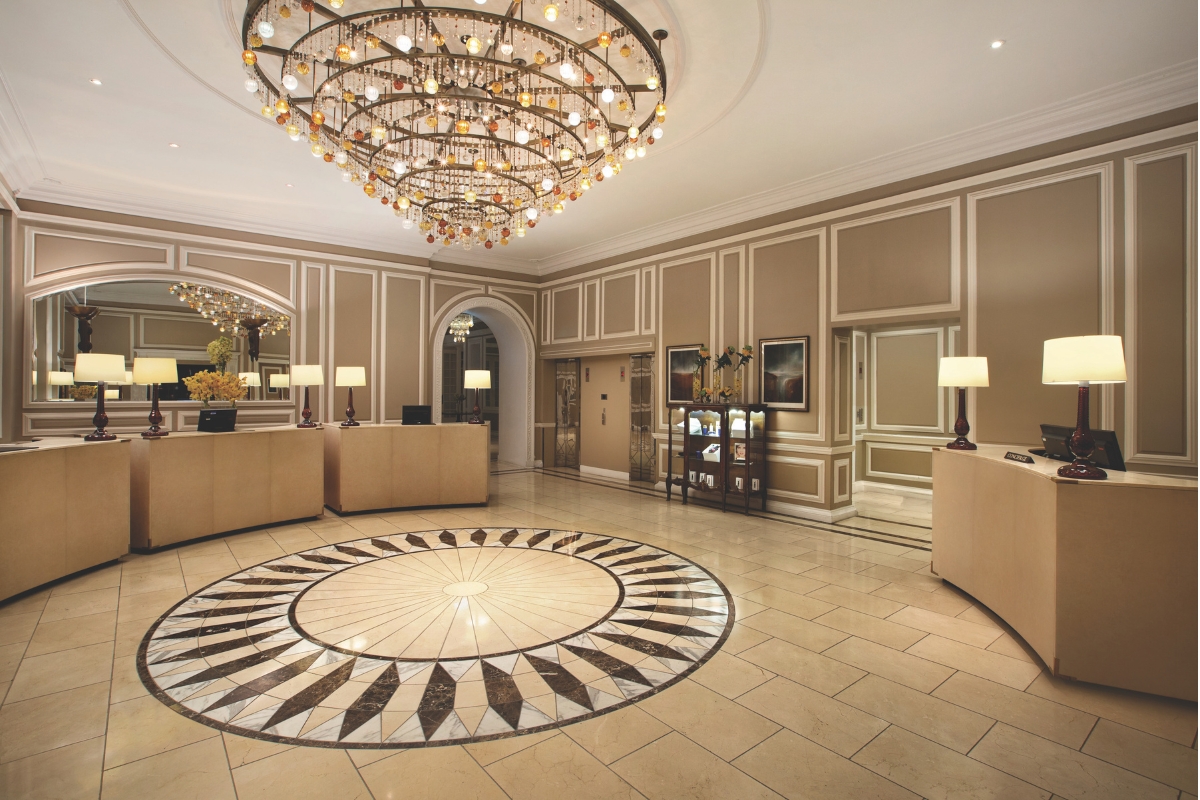Receive for Free - Discover & Explore eNewsletter monthly with advance notice of special offers, packages, and insider savings from 10% - 30% off Best Available Rates at selected hotels.
history
Discover the heritage of The Caledonian Edinburgh, which was once part of an active train station in the early 1900s.
The Caledonian Edinburgh, a member of Historic Hotels Worldwide since 2018, dates back to 1903.
VIEW TIMELINE
The History of The Caledonian Edinburgh
Explore this historic gem in the heart of Edinburgh.
WATCH NOWEdinburgh emerged as one of Scotland’s most vibrant cities by the end of the nineteenth century. Local industry flourished, attracting scores of ambitious people eager to participate in the country’s newfound prosperity. Accelerating this growth was the rapid expansion of new railways throughout the United Kingdom, transporting people at an unprecedented rate. Many businesses soon began spreading their railroads into Edinburgh, including the prolific Caledonian Railway Company. The Caledonian Railway Company added an extension onto its line in the city’s West End during 1890, traversing a portion of Princes Street in the process. Shortly thereafter, the company began planning the construction of a new train station to service the nearby neighborhoods. For the undertaking, it hired John More Dick Peddie and George Washington Browne. Together, they created an ambitious design that featured seven, large platforms at both ends of the station, while a luxurious hotel sat in the middle to accommodate any disembarking passengers. Construction finally began in 1899, and when it concluded some four years later, the new building amazed all who saw it. Greeting visitors was the beautifully crafted, rose-colored façade of the hotel’s front entrance. Once inside, guests found an extensive selection of 205 different lodgings, as well as gold-painted ceilings, marble columns, and a stunning grand staircase. With great pride, the Caledonian Railway Company christened the new building, “The Caledonian Hotel,” in 1903.
Known affectionately as “the Caley,” the building became one of the most esteemed hotels in all of Edinburgh. Guests were enchanted by the exhilarating galas and sumptuous banquets hosted regularly at the Caledonian. In 1923, the business opened an immaculate restaurant called “The Pompadour,” which rapidly transformed the location into a premier dining establishment. And under the tutelage of General Manager Arthur Towle and his son Sir William Towle, the hotel’s reputation continued to blossom. By the mid-twentieth century, the prestige of the Caledonian had attracted numerous celebrities from around the world. Marlene Dietrich, Judy Garland, and Gene Kelly were just a few of the distinguished people to frequent the building during the latter part of its history. In fact, the comedy troupe Laurel and Hardy coined their famous catchphrase, “Now look what a fine mess you’ve got me into Stanley,” at the hotel, after Stan Laurel dropped a cup of coffee onto one of its white tablecloths. Roy Rogers even once rode his famous white horse, Trigger, up the grand staircase amid a lively performance. While the train station is no longer active, the hotel remains as popular as ever. When Hilton Hotels acquired the Caledonian in 2000, it was still entertaining countless visitors, including many movie stars, international dignitaries, and royal monarchs. The Caledonian Hotel was even the site of a highly important European Council meeting that took place during 1992, in which prominent European politicians drafted the European Union’s Edinburgh Agreement. Now a member of Historic Hotels Worldwide, this fantastic historic destination continues to be an internationally respected luxury hotel.
-
About the Location +
One of Edinburgh’s most popular destinations today, Princes Street has been a major thoroughfare in the city since its creation in the early 18th century. Princes Street specifically traverses the Edinburgh’s historic neighborhood called, “New Town,” which UNESCO decreed a World Heritage Site in 1995. New Town itself dates to 1767, when the Edinburgh City Council approved plans to create a unique suburban district that would attract more affluent individuals to the area. To make their vision a reality, the council members commissioned architect James Craig for the project. Craig’s plan was audacious: a grid five-streets deep seven-street wide that featured grand square at each end of its central axis. Every street was named after a member of the British Royal Family in honor of the recent Act of Union that had finally unified Scotland and England in 1707. George Street would specifically operate as the area’s main traffic artery, which Craig had named in honor of King George I of Great Britain. Two gorgeous churches were to serve as the anchors for the scheme, with St. George Church situated at the western end and St. Andrew’s located to the east. Craig intended for his new neighborhood it only feature residential structures, as the Edinburgh City Council intended for the nearby “Old Town” to exclusively act as the local center of commerce.
The development of New Town, though took nearly five decades to complete, formally concluding with Robert Adam’s construction of Charlotte Square in 1820. Soon enough, many brilliant Georgian-styled townhouses and manor homes filled the district. Perhaps the greatest of those buildings was the Dundas House, which functioned as the home of Sir Lawrence Dundas. Designed with some of the most beautiful Palladian-inspired design aesthetics throughout the entire city, the Dundas House today serves as the headquarters for the Royal Bank of Scotland. Another brilliant landmark to appear within the neighborhood around this time was the magnificent West Register House, located in Charlotte Square. Now the National Archives of Scotland, this charming structure originally debuted as the West Register House in 1792. The New Town retained its unique residential character for some time until the railroads arrived at the height of the Victorian Era. While George Street had functioned as the focal point of the neighborhood since its inception, the installment of a train station along Princes Street in the 1890s quickly changed the dynamic. Many businesses soon opened in New Town as such, transforming Princes Street into one of the city’s foremost shopping districts—a reputation that the area still bears today.
-
About the Architecture +
In 1899, the Caledonian Railway Company hired architects John More Dick Peddie and George Washington Browne to design the hotel as part of a much larger train station complex. The two men had managed to secure the contract thanks, in large part, to Peddie’s father, John Dick Peddie. The senior Peddie was a renowned architect in his own right, having developed several financial buildings on behalf of the Royal Bank of Scotland. After completing his studies at the University of Edinburgh, John More Dick Peddie worked in the office of George Gilbert Scott before formally joining his father’s firm in the 1870s. Becoming a partner in 1878, the junior Peddie eventually brought on George Washington Browne as an associate. Together, the two men helped make their practice incredibly successful that by the 1890s, it had become one of the most prolific architectural firms in all of Scotland. The primary focus of their work remained centered on the creation of financial institutions, including the design of several branches within the British Linen Bank. Yet, the true genius behind the firm’s success was Peddie’s assistant at the time, John Wilson. Wilson specifically drew the initial blueprints for most of the company’s projects during the apex of its prosperity, designing such renowned buildings like the magnificent Edinburgh College of Art. His influence was even felt on the overall design of The Caledonian, as he was Peddie and Browne’s main project manager throughout its construction.
The Caledonian Edinburgh displays some amazing Renaissance Revival-style architecture, specifically a subset that embraced the design principles of the Flemish Renaissance. Renaissance Revival architecture—sometimes referred to as "Neo-Renaissance”—is a group of architecture revival styles that date back to the 19th century. Neither Grecian nor Gothic in their appearance, Renaissance Revival-style architecture drew inspiration from a wide range of structural motifs found throughout Early Modern Western Europe. Architects in France and Italy were the first to embrace the artistic movement, who saw the architectural forms of the European Renaissance as an opportunity to reinvigorate a sense of civic pride throughout their communities. As such, those intellectuals incorporated the colonnades and low-pitched roofs of Renaissance-era buildings, with the characteristics of Mannerist and Baroque-themed architecture. Perhaps the greatest structural component to a Renaissance Revival-style building involved the installation of a grand staircase in a vein similar to those located at the Château de Blois and the Château de Chambord. This particular feature served as a central focal point for the design, often directing guests to a magnificent lobby or exterior courtyard. Yet, the nebulous nature of Renaissance Revival architecture meant that its appearance varied widely across Europe. As such, historians today often find it difficult to provide a specific definition for the architectural movement.
-
Famous Historic Events +
Edinburgh Agreement (1992): Also known as the “Edinburgh Decision,” the Edinburgh Agreement was a political deal struck between Denmark and the presiding European Council in relation to the former’s rejection of the Maastricht Treaty. The Maastricht Treaty itself formally established the European Union in February 1992, in which the member nations of the preexisting European Communities decided to form a more centralized political union to better coordinate their respective social and economic affairs. At the time, 11 different countries in Europe constituted the European Communities and nearly all of them approved of the Maastricht Treaty. The only exception was Denmark, where a popular referendum held in June narrowly rejected the pact. Since the Maastricht Treaty could not become law until every nation within the European Communities singed the document, the other 10 nations scrambled to find a way to get Denmark’s approval. As such, the European Council—a body of dignitaries representing the political will of the pending European Union—met at The Caledonian to discuss the affair further that December. In the end, the European Union granted several concessions to Demark, which ultimately led to the country’s eventual approval in 1993. Those concessions essentially involved granting Denmark more autonomy in setting its domestic and foreign policies, as well as the preservation of the Danish krone. Today, the European Union is composed of 27 nations and is one of the most powerful geopolitical entities in the modern world.
-
Famous Historic Guests +
Charlie Chaplin, renowned actor known for his silent roles in The Kid and A Woman of Paris.
Judy Garland, actress and singer known for her roles in A Star is Born (1954), Meet Me in St. Louis, and Wizard of Oz.
Gene Kelly, actor known for his roles in such movies like An American in Paris and Singin’ in the Rain.
Marlene Dietrich, actress known for her roles in Morocco, Shanghai Express, and The Blue Angel.
Bette Davis, actress known for her roles in All About Eve, Jezebel, and What Ever Happened to Baby Jane?
Sean Connery, actor known for his roles in Goldfinger, The Untouchables, and The Hunt for Red October.
Elizabeth Taylor, actress known for her roles in Cleopatra and The Taming of the Shrew.
Anthony Quinn, actor known for his roles in such films like Zorba the Greek, The Guns of Navarone, and La Strada.
Roy Rogers, actor best remembered for his role on The Roy Rogers Show.
Fred MacMurray, actor known for such roles in Double Indemnity, The Absent-Minded Professor, and The Apartment.
David Niven, actor best remembered for his roles in such films like Separate Tables, The Pink Panther, and Around the World in 80 Days.
Stan Laurel, one half of the legendary comic duo, Laurel and Hardy.
Oliver Hardy, one half of the legendary comic duo, Laurel and Hardy.
Charles Aznavour, singer who sold well over 180 million records in his lifetime.
Bing Crosby, singer and actor known for his roles in Going My Way and The Bells of St. Mary’s.
Count Basie, big band leader known for leading the Count Basie Orchestra to national prominence from Chicago.
Perry Como, singer remembered as “Mr. C” who won five Emmy Awards.
Yehudi Menuhin, considered by experts to be one of the best violinists of the 20th century.
Rudolf Nureyev, ballet dancer who once directed the Paris Opera Ballet.
Jean Chrétien, Prime Minister of Canada (1993 – 2003)
John Major, Prime Minister of the United Kingdom (1990 – 1997)
Tony Blair, Prime Minister of the United Kingdom (1997 – 2007)
Mikhail Gorbachev, General Secretary of the Communist Party of the Soviet Union (1985 – 1991)
Nelson Mandela, anti-apartheid revolutionary and 1st President of South Africa (1994 – 1999)
Lee Kuan Yew, Prime Minster of Singapore (1969 – 1990)
Goh Chok Tong, Prime Minister of Singapore (1990 – 2004)
P.J. Patterson, Prime Minister of Jamaica (1992 – 2005)
Anne, Princess Royal
King Hussein of Jordan (1952 – 1999)
Emperor Naruhito of Japan (2019 – present)
-
Film, TV and Media Connections +
Let’s Be Happy (1957)
Lucia (1998)
Looking After Jo Jo (1998)
Festival (2005)
Driving Lessons (2006)
Hallam Foe (2007)
Death Defying Acts (2007)
Eisfieber (White Out) (2010)
Single Father (2010)
The Angels’ Share (2012)


























